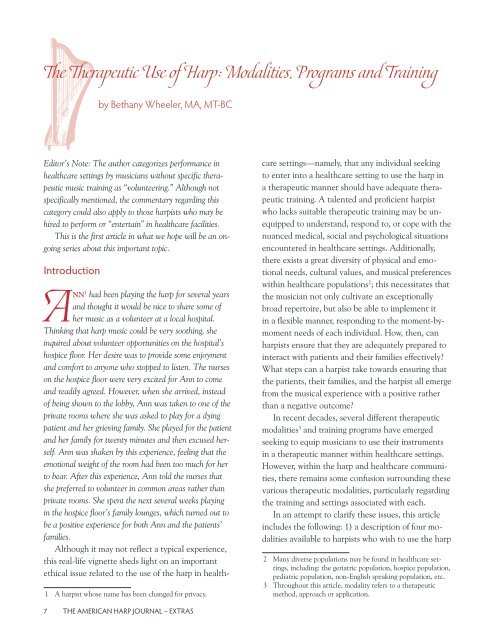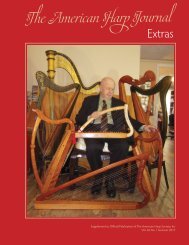The American Harp Journal - Extras - Summer 2018
Supplement to Vol. 26 No. 3 (Summer 2018) of The American Harp Journal
Supplement to Vol. 26 No. 3 (Summer 2018) of The American Harp Journal
You also want an ePaper? Increase the reach of your titles
YUMPU automatically turns print PDFs into web optimized ePapers that Google loves.
<strong>The</strong> <strong>The</strong>rapeutic Use of <strong>Harp</strong>: Modalities, Programs and Training<br />
by Bethany Wheeler, MA, MT-BC<br />
Editor’s Note: <strong>The</strong> author categorizes performance in<br />
healthcare settings by musicians without specific therapeutic<br />
music training as “volunteering.” Although not<br />
specifically mentioned, the commentary regarding this<br />
category could also apply to those harpists who may be<br />
hired to perform or “entertain” in healthcare facilities.<br />
This is the first article in what we hope will be an ongoing<br />
series about this important topic.<br />
Introduction<br />
ANN 1 had been playing the harp for several years<br />
and thought it would be nice to share some of<br />
her music as a volunteer at a local hospital.<br />
Thinking that harp music could be very soothing, she<br />
inquired about volunteer opportunities on the hospital’s<br />
hospice floor. Her desire was to provide some enjoyment<br />
and comfort to anyone who stopped to listen. <strong>The</strong> nurses<br />
on the hospice floor were very excited for Ann to come<br />
and readily agreed. However, when she arrived, instead<br />
of being shown to the lobby, Ann was taken to one of the<br />
private rooms where she was asked to play for a dying<br />
patient and her grieving family. She played for the patient<br />
and her family for twenty minutes and then excused herself.<br />
Ann was shaken by this experience, feeling that the<br />
emotional weight of the room had been too much for her<br />
to bear. After this experience, Ann told the nurses that<br />
she preferred to volunteer in common areas rather than<br />
private rooms. She spent the next several weeks playing<br />
in the hospice floor’s family lounges, which turned out to<br />
be a positive experience for both Ann and the patients’<br />
families.<br />
Although it may not reflect a typical experience,<br />
this real-life vignette sheds light on an important<br />
ethical issue related to the use of the harp in health-<br />
1 A harpist whose name has been changed for privacy.<br />
care settings—namely, that any individual seeking<br />
to enter into a healthcare setting to use the harp in<br />
a therapeutic manner should have adequate therapeutic<br />
training. A talented and proficient harpist<br />
who lacks suitable therapeutic training may be unequipped<br />
to understand, respond to, or cope with the<br />
nuanced medical, social and psychological situations<br />
encountered in healthcare settings. Additionally,<br />
there exists a great diversity of physical and emotional<br />
needs, cultural values, and musical preferences<br />
within healthcare populations 2 ; this necessitates that<br />
the musician not only cultivate an exceptionally<br />
broad repertoire, but also be able to implement it<br />
in a flexible manner, responding to the moment-bymoment<br />
needs of each individual. How, then, can<br />
harpists ensure that they are adequately prepared to<br />
interact with patients and their families effectively?<br />
What steps can a harpist take towards ensuring that<br />
the patients, their families, and the harpist all emerge<br />
from the musical experience with a positive rather<br />
than a negative outcome?<br />
In recent decades, several different therapeutic<br />
modalities 3 and training programs have emerged<br />
seeking to equip musicians to use their instruments<br />
in a therapeutic manner within healthcare settings.<br />
However, within the harp and healthcare communities,<br />
there remains some confusion surrounding these<br />
various therapeutic modalities, particularly regarding<br />
the training and settings associated with each.<br />
In an attempt to clarify these issues, this article<br />
includes the following: 1) a description of four modalities<br />
available to harpists who wish to use the harp<br />
2 Many diverse populations may be found in healthcare settings,<br />
including: the geriatric population, hospice population,<br />
pediatric population, non-English speaking population, etc.<br />
3 Throughout this article, modality refers to a therapeutic<br />
method, approach or application.<br />
7 THE AMERICAN HARP JOURNAL – EXTRAS




